Note: The screenshots posted on this page have been scaled up a little from their tiny native resolutions as well as had their aspect ratios corrected to proper 4:3 dimensions as they should have looked on CRT monitors originally. For posterity’s sake you can also click them to view the “pixel perfect” originals.
Introduction
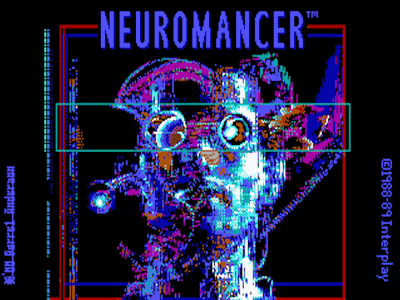
“Neuromancer!”
One of the best part of being into retro gaming and, indeed, doing these reviews, is exploring all manner of interesting and bizarre games that I’ve never played and in many cases had never even heard of before. 1988’s Neuromancer is a standout example of this. Containing so many individual elements that I’m particularly drawn to, from its dark cyberpunk setting to its late 80s adventure game trappings, never mind that William Gibson’s Sprawl Trilogy are some of my favorite books, on paper, this is my dream game. Yet, it’s a game that I nor practically anyone I know had played, despite being based on a hugely influential novel, being somewhat innovative for its time, and even being considered a bona fide classic in certain circles.
The story goes that at some point in the mid 80s, counterculture LSD fanatic Timothy Leary read William Gibson’s Neuromancer and it changed his life. Not too much earlier, he had also discovered the captivating world of interactive fiction games, which had also changed his life. At some point the potential intersection became obvious, and Leary obtained the rights to make a game based on Neuromancer, eventually partnering up with Brian Fargo at Interplay, who ultimately designed, developed, and published the game. Unfortunately Interplay had just released cult-classic Wasteland under Electronic Arts, and were soon to release an absolute must-have at the time, Battle Chess, sandwiching Neuromancer into relative obscurity.
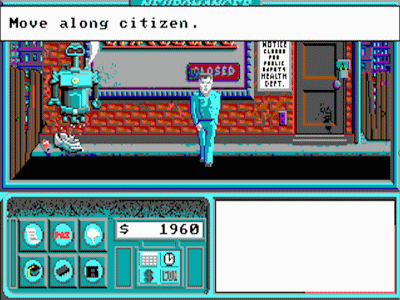
“A robot? What game is this again?”
Adding to that obscurity, Neuromancer’s release fell in what was an extremely awkward period for PC gaming; a transitional time between the end of the 8-bit personal computer era and the widespread popularity of the newer 16-bit computers like the Amiga and the Atari ST, and of course, the rise of the IBM PC as a popular gaming platform. IBM PCs took a little bit of time to catch up, however; low color but higher resolution EGA was still in vogue, and add-on sound and music cards such as the Adlib and Roland’s MT32 hadn’t begun to see widespread use yet. On the other hand, Neuromancer was somewhat of a tour de force on squeezing content into and power out of its lead platform, the aging Commodore 64.
For this review I’m playing through the inferior IBM PC version, but honestly, this lackluster port probably only adds to the quirkiness of this already unique game.
Gameplay
Another side effect of this awkward, transitional period of gaming, is the gameplay itself. By the late 80s a lot of PC games were extremely creative affairs, including all kinds of new and experimental gameplay concepts, often forced together in unusual ways, and many of the genre tropes we take for granted today hadn’t quite been established. Unfortunately that meant that when those genres did get more established, some of these transitional, experimental games became evolutionary dead-ends, as it were. In my King’s Quest review I talked about the design and even UI differences between King’s Quest’s AGI and SCI versions. Neuromancer takes a lot of adventure game ideas from old AGI games and their contemporaries, but also tosses in a huge helping of roleplay, and then throws in this massive twist of online interfaces including exploring cyberspace itself. You could easily argue that Neuromancer has more akin to classic graphical RPGs than run-of-the-mill adventure games like King’s Quest. That doesn’t make it a bad game by most standards, but it does make it a weird one.
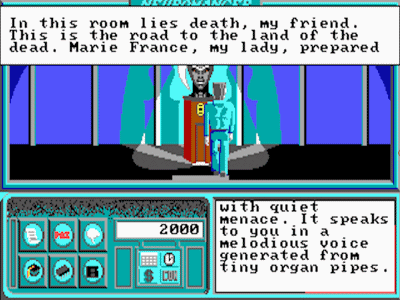
“The end of the book would have been a lot shorter if Neuromancer was just chilling in the lobby.”
Neuromancer is split into several different, distinct gameplay systems, but for the sake of simplification, let’s reduce this down to two halves, which roughly represent the two halves of the game (though it is a semi-nonlinear game, so it’s definitely possible that you won’t have anything even close to a 50/50 split.) First, there’s the offline adventure section.
Neuromancer starts with your character standing on a screen representing a bar, where you’ve apparently just woken up after a rough evening of drinking and eating pasta. A text box describes the scene for you, and the bartender barks at you. From here, the game looks like a traditional adventure game, albeit an archaic, odd twist on some of the more conventional tropes of the genre. You can walk around these screens, navigating the city, and talking to various characters along your way, but that’s about the extent of it. Talking to people can get you some useful information, but it mostly serves as a way to upgrade your skills and equipment. In other words, almost every character is a traditional RPG shopkeeper NPC.
Your other options in the overworld are more interesting – you can access PAX terminals, which let you access basic banking functions, and read message boards, which work a bit like old school BBSes. The messages mostly contain background fluff but sometimes contain useful information too. You can even send messages, which is used once or twice as a solution to a puzzle, as it were.
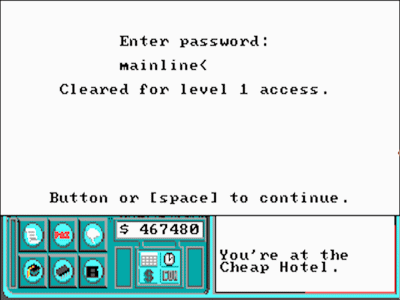
“You’ll be entering a ton of linkcodes and passwords early in the game.”
Finally, there are access ports, which is where things really start to get interesting. By using your cyberdeck in an area with a port, you can use a software application called “Comlink” to connect to various databases, or “bases.” Comlink is something akin to a terminal program, and bases are similar to old dial up BBSes: Small, closed off systems that consist of memos, files you can download, more message boards, and sometimes other special functions. As a BBS junkie from way back, it’s pretty fascinating to see a view of what the Internet might be like in the future looking through the contemporary lens of dial-up BBSes and mainframe systems. It’s also interesting to note just how much the users of these apparently futuristic online systems resemble those of the underground BBS scene of the 80s and 90s. This was an unexpected shot of nostalgia for me!
Anyway, to connect to a base you need to know its linkcode, which is something like an AOL keyword, if anyone remembers those. Once connected, you’ll then need a password to get access. Bases have multiple levels, each with its own password. Once you’re on, the main function of these “bases” is essentially to provide more linkcodes and passwords to other bases, or hints to find and figure new ones out, as well as downloads for improved software, to progress, with higher levels usually having some additional, previously inaccessible messages, downloads, or other functions.
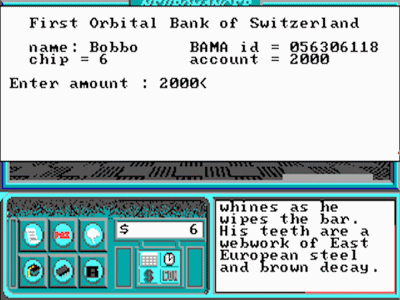
“In retrospect I’m not sure why I thought online banking would make a good screenshot.”
Hints are important in Neuromancer, because, despite being fairly non-linear in terms of structure, progression is generally guided by a series of gates: Do you know a linkcode to connect to a base? Do you know the access code to get into the base? Do you have a high enough version of Comlink to work with a base? Do you have some other required software or know the appropriate level of skill to “solve” a puzzle? These questions are answered one by one in a fairly orderly way. The biggest challenge, generally speaking, is trying to keep track of the vast amount of information you’re given. You may have half a dozen or more of these micro puzzles progressing at any one time. This is a game that requires taking notes if I’ve ever played one. By the time I was halfway through I had a notebook that looked like the scribblings of a madman, filled with linkcodes, encrypted and unencrypted passwords, names, places, account numbers, etc.
Surprisingly, this stage in the game isn’t quite as tedious as it sounds. You don’t have to do too much walking around, the fluff is interesting and even a little funny when it works, and the act of juggling all of this information, manipulating people and systems, connecting to a base, snooping around in it, taking what you’ve learned to connect to the next one, etc. actually starts to feel a lot like something resembling legitimate, largely social engineering powered, hacking. In fact, at this point Neuromancer feels more like some odd twist on a hacking simulator than any sort of adventure game.
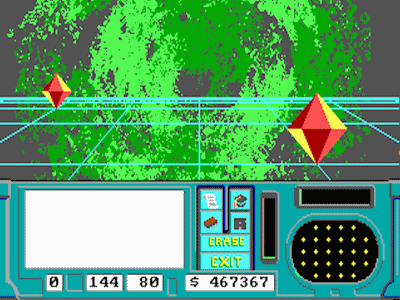
“Welcome to cyberspace!”
That, and the puzzles aren’t as frustrating as vintage PC gaming veterans are probably imaging from a 80s game where information gathering and solving puzzles is the order of the day. The fact is, for the most part, the different puzzles and their solutions are strung together fairly well, and there are never too many of these little mysteries sitting there, unsolved, at any one time. That might not sound like a big deal, but it’s far easier to figure out your next move based on a few distinct clues than it is to figure it out when you have 10s of them pointing you in every possible direction.
Eventually with all of the skills you’ve learned and software you’ve gathered, you’ll manage to make some extra cash from all of your hacking exploits, and can upgrade your deck to something “cyberspace capable”. Once you have one of these decks, not only can you use Comlink to connect to bases, but you can enter the Matrix, and thus begins the second half of the game.
Cyberspace is essentially a graphical representation of the back-end infrastructure of the aforementioned individual bases. As you move through the Matrix you can connect to the same databases in virtual space, but this time you can access them through their back doors. People aren’t complete morons in this imaginary future, however: all of these back doors are protected by ICE, or Intrusion Countermeasures Electronics, which means you need to perform some hacking to get in. Hacking ICE requires using a rotation of programs on your deck to damage or otherwise weaken the ICE, as well as occasionally repair your own systems. You select one of your available programs and wait for it to affect the ICE. Meanwhile, the ICE is firing back with its own damaging hacks. It’s honestly not incredibly thrilling, but you still need to be on your toes. Once the ICE is defeated, you have maximum access to the base. Sometimes this means newer information and software than you previously discovered access to, sometimes not, but generally speaking completing these hacks helps you progress your character’s ability to move deeper into cyberspace.
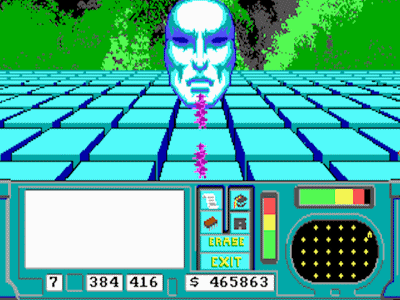
“Attempting to defeat an AI.”
Sometimes when you defeat a base’s ICE you wind up not in the database, but staring down an AI. Unlike the Sprawl Trilogy this game was based on, their seems to be quite a few AIs running around the Matrix. Each AI has its own personality and take on and involvement in the overarching plot of the game. To defeat an AI you use your various skills in much the same way as you used your deck’s software; rotating through different skills to cause damage and healing yourself when required while the AI takes turns pummeling you back. A lot of these fights can be pretty close, but if you’ve been keeping your skills and warez up, you should beat any AI the game intends for you to be able to beat.
As to that intention, the different areas or “zones” of cyberspace, and to a lesser degree individual instances of ICE and AI, are gated by your level skills and software, which is essentially the gameplay loop of this last section of the game: access an area of cyberspace, hack all of the bases and defeat all of the AIs to upgrade your software and upgrade your skills, respectively, and then move on to the next area. Again, very RPG-like. There are some minor diversions along the way, but at this point the game turns into a bit of a slog until you eventually go head to head with the titular AI, Neuromancer, in one last, climatic battle.
Story
Sadly, despite being based on a celebrated novel, Neuromancer’s story is not one of its strong points.
For one, there’s barely any narrative to speak of. Instead, the game is a bit of a hamfisted execerise in “environmental storytelling”; it seems that you’re supposed to take a lot of context out of the presentation of the world itself, with what isn’t inferred from the setting found in text stashed on PAX and database message boards, crushed between various pieces of fun but perhaps ultimately distracting fluff. In fact, there’s so much of this other stuff that it can be hard to identify what is and isn’t actually supposed to be relevant to the plot. Honestly, I can easily imagine someone who hadn’t read the book being completely lost by this method of delivery.
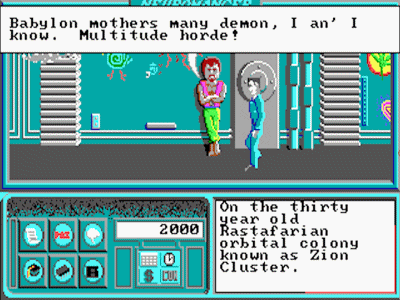
“Maelcum’s cringeworthy faux-Jamaica is lovingly recreated. Yay.”
Hopefully you’ll eventually piece together that many of your fellow “console cowboys” have gone missing or have been “flatlined” in what sniffs of conspiracy. You then discover that a group of rogue AIs are responsible and defeat them one by one, leading to a confrontation with Neuromancer. Neuromancer then brags about having manipulated you the entire time into doing its bidding, including taking out the other AIs so that it could assume control of the Matrix. As reductive as that sounds, that’s the plot.
Fans will note the obvious departures from the plot of the novel. While sure, along with Wintermute, Neuromancer, is an AI who manipulates a hacker into serving its cause, there’s quite a bit more nuisance in the original story that is simply left out of the game. While there are quite a few details from the book mentioned in the game, including numerous references to characters, events, companies, technologies, and places, they mostly feel like very surface-level references, or even homages to the original story, than anything resembling an adaptation.
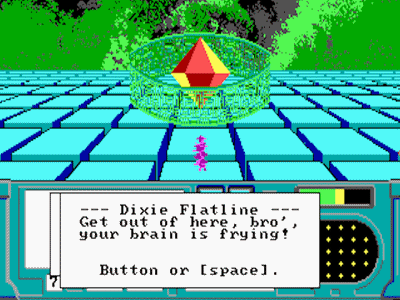
“Dixie Flatline’s ROM-construct also makes an appearance… for some reason.”
Here’s my personal “headcanon” take on how the game’s story relates to that of the novel. First, if it’s not obvious, you’re not supposed to be playing Case, the main protagonist of the book, but a different character that just so happens to also be a down on his luck hacker living in Chiba City. Running in the same circles as Case, your character just so happens to interact with some of the same people and somehow wind up in some of the same places as he does. This character’s manipulation by Neuromancer, however, takes place before the events in the book, with Neuromancer attempting to level the playing field for itself before its more existential endgame in the novel. I think that works?
That all said, the story is presented as such an afterthought, that while it may disappoint those looking for a faithful adaptation of the plot of the novel, it didn’t have a major impact on my enjoyment of the game. It succeeds in giving us an interesting setting, at least.
Controls
In the more traditional offline “meatspace” adventure sections of the game, you’re presented with the typical third person view of your character in the immediate area you’re in. Navigating here is fairly rudimentary, with most screens only representing a single room with no scrolling or scaling as you move around. Moving is really only useful for navigating to an exit, as your character’s position is not typically a factor in being able to interact with people or objects. Similarly unsophisticated, each room tends to only have a single exit per side of the screen. Compared to most graphical adventure games, even much older ones, all of this might sound depressingly limited, but it somehow works just fine in practice.
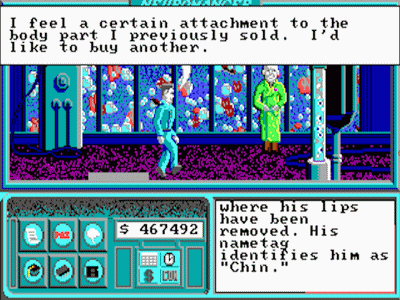
“Being able to sell your organs for cash should be a standard feature in games.”
Your ability to move around in the UI tends to be more important, as you’ll be spending much more of your time interacting with it than the world around you, especially as the game progresses and you spend the majority of your time face down in your cyberdeck. There are a handful of menu options available at almost any time, most notably your skill and item inventories where the bulk of your actions derive from, as well as dedicated conversation and PAX access options that’ll you’ll be using a lot in the early game while still navigating the world. Anyone who is used to working in command line environments or other text based, hotkey driven programs should be able to pick up on it right away. While it’s a little archaic, the menu-heavy interface probably works better in the context of Neuromancer than other games from that era, and I found that it actually lead to feeling like I was really hacking around in these computer systems, adding greatly to my immersion in the gameworld.
Curiously enough for a game from 1988, I suppose as a nod to the newer, more mouse orientated 16-bit PCs, Neuromancer also includes fairly comprehensive mouse support. Along with performing some extremely basic “click to move” movement in the adventure sections, you can click menu and action buttons in the main UI overlay and most of the hotkey text options in the menus. Between typing in linkcodes and passwords and using the “Tell me about…” conversation option, which requires typing nouns into a simple text parser, I found it to be a lot more efficient just to get used to navigating the UI as well as moving my character strictly via keyboard so I wouldn’t need to keep switching back and forth between keyboard and mouse. Still, even if I didn’t use it, it’s neat that they decided to include it.
Graphics
Neuromancer’s graphics are a mixed bag. While it makes full use of EGA’s 320×200 resolution, packing a fair amount of detail into the world in addition to the descriptive text in the UI, and enough lines of text in the various interfaces to not feel too cramped, it
s default 16 color palette gives the graphics a harsh and primitive look that I, personally, don’t love. If you look carefully at the sprites and backgrounds, Interplay’s artists actually made damn fine use of the very limited palette, but that doesn’t stop the world from feeling drowned in otherworldly hues of cyan, purple, and green as typical of most EGA graphics. I admit, this is mostly a personal preference thing. While the animations aren’t anything to write home about either, the general art style and design of the world, despite not at all what I might have imagined when I read the book, have a distinct and enjoyable character for sure.
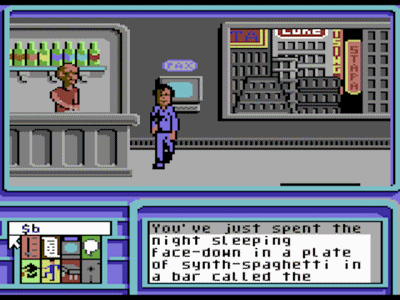
“Waking up in Chatsubo bar: Commodore 64.”
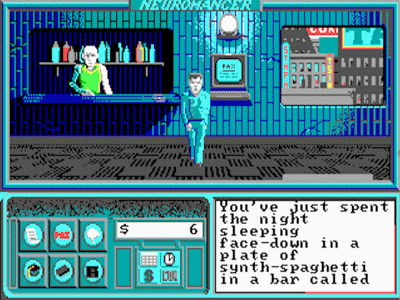
“Waking up in Chatsubo bar: IBM PC.”
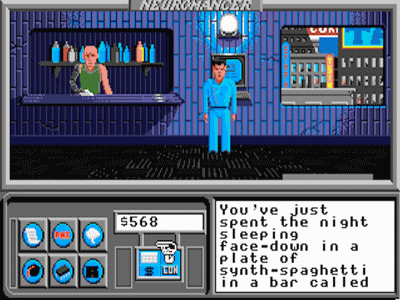
“Waking up in Chatsubo bar: Amiga.”
Obviously rendered at a lower resolution than its IBM and Amiga counterparts, the stylization in the Commodore 64 version is totally different and, in my opinion, actually superior. Your character has a different hairstyle, resembling the character in the title screen rather than sporting a bizarre flattop. In fact, everything is different, with the amount of detail they managed to squeeze into its few pixels of backgrounds and sprites, including more variety into the otherwise plain PAX and base menus, it’s so much more charming. In comparison to the IBM PC version, the addition of more suitable colors is a vast improvement over characters’ ghoulish white skin and the stark EGA neons on display throughout. The Amiga version rectifies the IBM PC version’s weird color palette, looking more akin to a 90s VGA game, yet the stylization issues remain. While many people probably consider the Amiga port the definitive version, I’d definitely cast my vote for the C64.
Sound
Speaking of the Commodore 64, by 1988 it was a mature machine; developers had figured out ways to squeeze every ounce of potential out of it, including its legendary SID sound chip. Neuromancer is a great example of this all around, but its sound is a real head turner. For a C64 game it’s quite technologically impressive, featuring probably the first licensed, digitized soundtrack in a game. Devo’s “Some Things Never Change” provides the opening theme music, and a reworking of it provides occasional loops of in-game music. Of course, it mostly sounds like trash by today’s standards, but compared to the IBM PC version’s (admittedly catchy) blip-bloppy PC speaker rendition, it’s a huge step above. Even the Amiga version’s waveform composition of the track, while definitely an upgrade, is still a pale imitation of the C64 version.
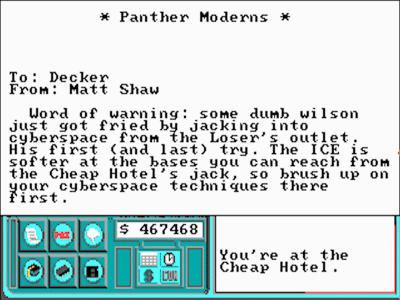
“A rare, not-so-subtle hint… for dumb wilsons.”
On the other hand, despite each port of the game having some version of this track, it’s rarely played in-game and the rest of the sound effects are almost non-existent. Simple blips and blops for only a very few actions, and the rest of the time… total silence. Great!
Old Age
As usual, I played through the entirety of Neuromancer on my dedicated gaming 486, usually with my internal cache disabled to slow the processor down to 386-like speeds. There weren’t any major speed related issues I ran into with the game. Most noticeably, the scrolling text that appears in various menu interfaces throughout the game scrolls a little quicker than it should. I also ran into a problem where, with my cache enabled, my mouse clicks were often detected twice. This was an easy problem to work around by simply moving my cursor to a non-clickable part of the screen immediately after clicking a menu option, but it could still be annoying if you intend to use the mouse. Given those issues, it wouldn’t surprise me to learn of other speed related issues.
Beyond playing it on the real thing, it appears that the last couple of versions of DOSBox fully support Neuromancer, listing 100% compatibility with it. I never got around to trying it personally, but given its age and relatively simplicity, I’d certainly guess it would run absolutely perfect in DOSBox.
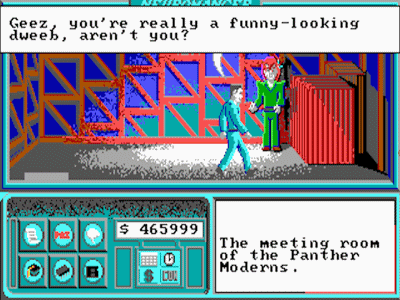
“Honesty is the best policy.”
Obtaining Neuromancer is another matter, however. Neuromancer exists firmly in the realm of abandonware these days. I know of absolutely no way to acquire it legally without finding a second hand copy of the physical release, and last time I checked eBay, prices were fairly outrageous. Fortunately, you can find the game on various shady abandonware sites quite easily. The more popular versions, like the Commodore 64 and Amiga ports, tend to be even more widespread, showing up on various enthusiast sites. I should point out that the game does include copy protection, originally coming with one of those annoying “code wheels” that you’d need to use to look up a keyword any time you access a PAX terminal. Of course, just about any version you download these days will already be cracked.
I’ve already talked quite a bit about some of the other versions of the game, but in addition to the awesome Commodore 64 version there is an Apple II port which has the same graphical style though, running at a lower resolution, looks a lot worse. Of course, it doesn’t include the digitized music either. Unusually, there’s also an Apple IIGS port. Very similar to the Amiga version, this one has the same graphical style including the higher color graphics, and similar waveform music and sound effects.
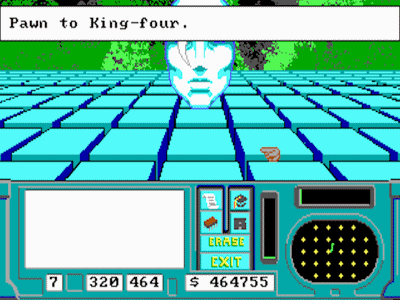
“It’s all just a game, after all…”
Scans of Neuromancer’s documentation are fairly widely available. Reading the manual isn’t necessarily required, but I’d recommend it due to it providing a good introduction to the story and overview of most of the game’s various systems. As usual, ReplacementDocs and Archive.org are places to start. There are also scans of the official hint book floating around. It’s kind of neat, written entirely as an in-character narrative, but I can’t recommend it as more than an interesting artifact since it’s an extremely linear walkthrough that removes any and all challenge from playing the game. I’d recommend at least trying to solve some of these puzzles yourself.
Sequels and Related Games
For what seems like the first time in one of these retro reviews, there are absolutely none. There were no sequels, and to my knowledge there are no other games based on Neuromancer. While you could possibly point to some of Interplay’s other games from around this time as related games, to my knowledge, none of them are directly related to Neuromancer’s engine or play anything like Neuromancer. Yet again, living up to my statement about it being unique.
Closing
Since, as mentioned, Neuromancer and its sequels are some of my favorite books and the game itself is a potent mix of a lot of my favorite elements, I’m definitely glad I played through this. On the other hand, unless you find yourself as similarly drawn to it as I was, it’s hard to recommend. The game is definitely interesting, with its unique mix of adventure, roleplaying, and hacking gameplay, and I haven’t played too many games that feel intimidatingly large and open, yet progress in such a fairly logical and linear way. Yet, the actual mechanics, from the simple implementation of the adventure game sections, to the repetitive and not particularly deep cyberspace ICE and AI battles, don’t quite stand out enough. Even though the Commodore 64 version in particular was technically impressive at the time, the game isn’t particularly historically significant either. If it’s simply the cyberpunk setting you’re after, there are games that pull off the atmosphere better, or you perhaps you could just cut out the middleman and check out the book!
I don’t usually cite sources when putting together these reviews due to the sheer amount of reviews, articles, walkthroughs, and other material that I read while working on them. That said, this awesome article about the history of Neuromancer’s development is just too fascinating not to share.